Animals
Fish and Aquatic Wildlife
Fish live in the three segments of the river, in the clean segment it is possible to find the Yarkon’s unique Breams, Catfish, Carp, Eels, Pangasius and Gannets. In the Yarkon’s salty segment there are large amounts of Kipon (Mullets), Eels and Tilapia near the river’s banks in areas with stone infrastructure and hiding places. In addition to the different fish, you can find different species of invertebrates, insects, bugs and worms.
The common fish in the Yarkon are:
- The Yarkon Bream (Acnthobrama telavivensis, Goren, Fishelson and Trewavas, 1973)- The Yarkon Bream is the prominent representative of the Carp family in the coastal stream system and is endemic in the Yarkon River. The Yarkon Bream is a rather small fish, and the length of its body is up to 120 milimeters.
- Common Carp (Cypinus carpio, Linnaeus, 1785)- The Carp is a tall fish (its height is a quarter to a third of its length). The length of its body is usually 300-500 millimeters, but it can reach a meter. It exists in pools and quiet parts of the river.
- Kipon Mullets (Mugil cephalus Linnaeus, 1758)- The Kipon, which lives in the Mediterranean Sea, enters rivers that spill to the sea. In the Mediterranean it reproduces in the fall, the eggs are laid in shallow water near the shore and many of the minnows wander into the streams spilling into the sea.
- Thinlip Mullet (Liza ramada, Risso, 1810)- Similar to the Kipon Mullet. Procreates in fall in shallow water near the shore. Its minnows, like those of the Kipon Mullet, wander up the streams. This fish and the Kipon Mullet are the main species of fish populating the lower segment of the Yarkon.
- Gambusia (Gambusia affinis, Baird and Girard, 1854)- The Gambusia are small fish. The length of the male’s body reached 40-50 mm, and the female’s to about 70 mm. Its body is silver with a bluish sheen, the back is at times an olive-brown.
- Galilee Tilapia (Sarotherodon galilaeus, Artedi, 1757)- The length of its body reaches 200-260 millimeters, and in rare occasions up to 380 millimeters. Its body is tall and its color is silver-gray. In Israel it can be found in the entire Jordan system and in several streams in the coastal system in which the water flow isn’t fast, as well as in pools and lakes.
- Nile Tilapia (Oreocromis niloticus, Linnaeus, 1757)- The Nile Tilapia is common in rivers and lakes in East Africa. In Israel a few items of this species were spotted only in parts of the Yarkon and its origins- the springs of Rosh HaAyin.
- Redbelly Tilapia (Tilapia zillii, Gervais, 1848)- Of the smallest of Israel’s Tilapia. Its length usually reaches 200 millimeters, rarely 300 millimeters. In Israel it is common in all water systems, in rivers whose flow isn’t too fast, in pools and in lakes.
- Sharptooth Catfish (Clarias gariepinus, Burchell, 1822)- The largest of the sweetwater fish of Israel, reaches a length of almost one meter, and rarely even a meter and a half and a weight of over 20 kilograms. The Catfish is a groundfish, living between rocks and plants. In places in which the river floor is muddy, it digs itself into the mud.
- European Eel (Anguilla angulla, Linnaeus, 1758)- A snake shaped fish. Reaches a length of one and a half meters and a weight of 15 kilograms. Eels are distinct groundfish, residing among rocks and stones or buried in mud. As they wander up the streams they pass, at times, in extremely shallow streams, and even out of the water in the mud.
- Iridescent Toothcarp (Aphanius mento, Heckel, 1843)- A small fish about 50 millimeters long. The toothcarp is silver-gray with a brown back. The toothcarp resides in clear water, in thickets of water plants and among rocks.
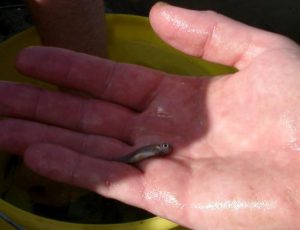
Lebanon Hayarkon (Photo: Yarkon River Authority)
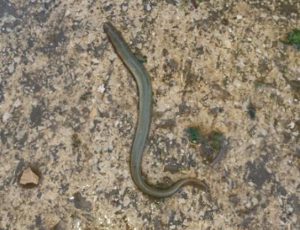
Eel (Photo: Yarkon River Authority)
Waterfowl and birds
Along the river live many species of waterfowl and birds, some year-round and some winter birds. The prominent year-round ones are Waterhen,Night Herons and Pied Kingfishers. Wintering in the Yarkon are different species of herons: Large Egerts, Little Egrets, Gray Heron, Cormorans and Common Kingfishers. Around the river, in the vegetation and trees live crows, kestrels and many songbirds. In the area are also a number of invading species, the most prominent of which is the Myna, a species from the starling family that experts believe came from the Safari. The Drara, a type of parrot, is also an invading species that has spread all over the country.
Birds in the Yarkon area- a short guide:
- Night Heron- The Night Heron, per its name, is active mostly in the evening and nighttime. In the daytime it can be seen napping on trees by the water, with her neck crunched in a stumpy silhouette.
- Gray Heron- The Gray Heron is perhaps the largest bird residing almost permanently by the river. Its wingspan can reach about two meters. Its flight is slow, its sound is raspy and it can usually be seen standing on the tops of the Eucalyptus trees, high above the other birds.
Common Kestrel- The Common Kestrel is the most common diurnal (daytime) raptor in the Gush Dan area. It has excellent vision and it hunts insects, reptiles and small mammals from a great height. - Egretta (small and large)- The Egretta is easy to recognize due to the plume of white feather decorating the back of its neck. The Small Egretta’s height is about half a meter and the large one is about a meter, and it nests in bushes and in dense trees surrounding the Yarkon. In the daytime it can be seen walking along the riverbank.
- Pied Kingfishers- The Pied Kingfisher is part of the kingfisher family. It is common around the river’s banks. The Pied Kingfisher is considered Israel’s champion in diving from a great height and in the evening and morning hours it can be seen hovering over the river and diving into the water after fish.
- White- throated Kingfisher- The White-throated Kingfisher is considered one of the more colorful birds on the banks of the Yarkon. It was nominated to be the national bird due to the fact that its rare blue color- created by its unique physical feather structure- is reminiscent of the Israeli flag. Despite its name, it actually lives well on lawns.
- Common Kingfisher- The Common Kingfisher is small, its length does not exceed twenty centimeters, with about a quarter of them owed to the large beak that makes it an excellent fisherman. It usually stalks its prey by standing on a branch or bush near the water and diving in quickly after it.
- Common Kingfisher- The Common Kingfisher is small, its length does not exceed twenty centimeters, with about a quarter of them owed to the large beak that makes it an excellent fisherman. It usually stalks its prey by standing on a branch or bush near the water and diving in quickly after it.
- Waterhen- Considered an expert in camouflage and during most daylight hours hides between the reeds along the riverbank.
- Mallard- The Mallard is the most common duck in the “Ganei Yehoshua” Yarkon Park. The head of the male is bright green and very recognizable, the female is spotted in shades of brown and they both have a prominent plume of blue-green feathers called a flag on the back part of their wings. They can be found mostly in the Seven Mills area and along the Yarkon.
Invading species
- Egyptian goose- The Egyptian goose is a large, solid waterbird and is considered one of the most common invading species in Israel. Its color is an orange brown and its wings are spotted in white, black and green. Around its eyes is a dark brown spot.
- Common Myna- The Common Myna (also known as Indian Myna) is the most common invasive species in the parks along the Yarkon. It is active among the trees as well as on lawns and walkways in all its parts. The Mynas usually live in groups of about ten and they are easily recognizable thanks to their yellow “eye shadow”.
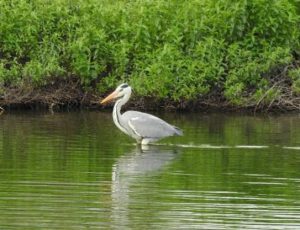
Gray branch (Photo:Yarkon River Authority)
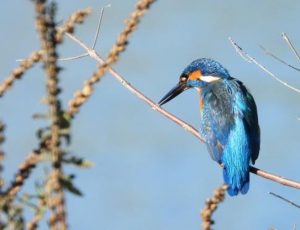
Dwarf shrew (Photo: Daphne Polak)
Reptiles
Turtles are the main reptile in the Yarkon River’s ecosystem. Softshell turtles live in all parts of the Yarkon, including the salty one, as well as swamp turtles in the sweetwater and reclaimed water parts. The Yarkon has 11 turtle slopes, these slopes make it easier to monitor the turtles’ egg laying. The Yarkon River Authority is participating in a survey conducted by the Israel Nature and Parks Authority regarding softshell turtles in the Yarkon area, as part of a national survey of the softshell turtle. The survey monitors the number of nests in and around the river in order to assess the size of the population. In 2020, 17 nests of softshell turtles were located in the Yarkon, marking an increase compared to the sampling done a year prior.
- African softshell turtle (Trionyx triunguis)- A species of turtle living in both sweet and saltwater. The African softshell turtle is the only representative left of its kind (Trionyx), in the past many species of softshell turtles were placed in this genus, but they were moved to other genera. In the genus of the African softshell turtle were found in the past over 15 species that have become extinct over 40 million years ago. The African softshell turtle is the only softshell turtle living in Israel, in which it is under extreme danger of extinction, due to the disappearance of habitats, river pollution and widespread illegal poaching.
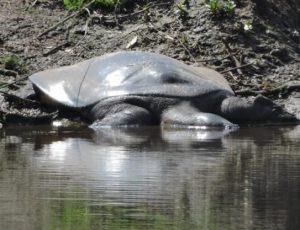
Soft turtle (Photo: Yarkon River Authority)
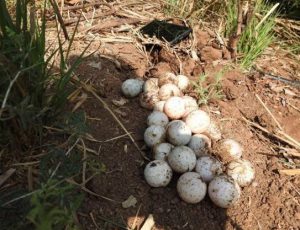
Soft turtle nest (Photo: Yarkon River Authority)
Mammals
The main large mammals living along the Yarkon are the Coypu (nutria), who feed off of the plants in the river’s water and on its banks. The Nufarim Pool got its name due to the fact that the coypu eats most other submerged vegetation, including the Blue Water Lily that once grew in the area, leaving only Yellow Nufars. In the area up the stream there is an undefined population of swamp cats and occasionally one can find porcupine quills.
- Swamp cats- The swamp cat is about four times larger than a house cat, its tail is short, and the weight of the average male reaches about ten kilograms. As per its name, it loves water, is a good swimmer and feeds, among other things, off fish it catches out of the water in its mouth. In the past, its habitat in Israel was limited to wet areas, but with the draining of Israel’s swamps it became less widespread. It is estimated that about 600 swamp cats are left in Israel.
There have been a small number of sightings of swamp cats in the Yarkon area in the last 30 years. The swamp cat serves as an indicator, as it is the top predator of the area, therefore its presence signifies a healthy ecosystem in the Yarkon River. This period is its parturition season- and we look forward to seeing the next generation as well.
- Golden Jackal- A mesopredator from the canine family. The jackal is mostly active during sunset and sunrise, but activity has also been spotted in the morning and afternoon hours. When a band of jackals forms, the members of the pack act as one unit, in remarkable coordination. This behavior optimizes important actions such as hunting and taking care of offspring.
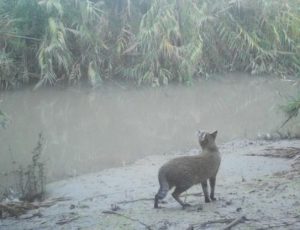
Swamp cat (Photo: Yarkon River Authority)
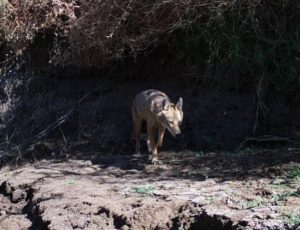
Golden Jackal (Photo: Yarkon River Authority)
The Yarkon River Authority
Adress: Kiryat Atidim Building B7, 2rd floor
Mailing address: P.O. 58292
Phone: 03-5460233
Email: [email protected]